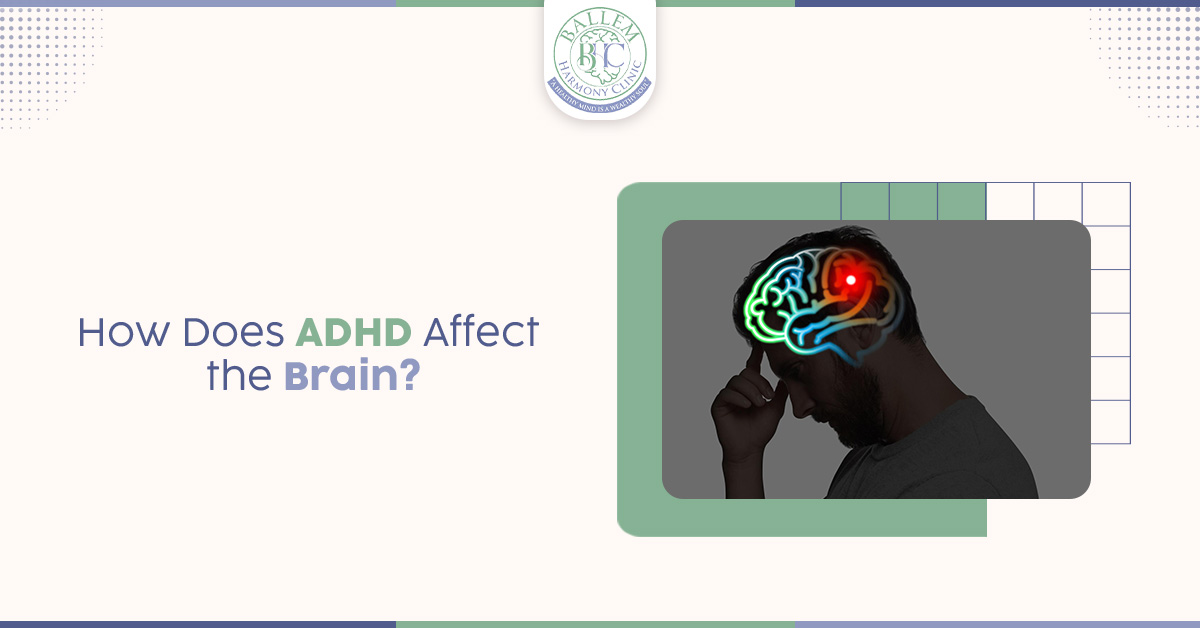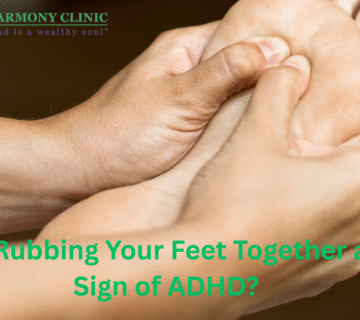ADHD is more than just distraction or extra energy. It’s a neurodevelopmental disorder that impacts brain network development and function. Several years of research have found the different effects of ADHD on various brain regions.
The prefrontal and basal ganglia processes are essential areas of the brain. Other key parts are the anterior cingulate, caudate, putamen, hippocampus, amygdala, and nucleus accumbens. Individuals with ADHD are delayed in the development of certain brain regions. Their brains are smaller and connect differently than typical ones.
Low levels of dopamine and norepinephrine are associated with ADHD. These neurotransmitters are key for motivation and reward. They also help with inhibitory control. This makes it tough to manage selective attention, impulsivity, and emotional regulation.
Brain Structure and Neuroplasticity in ADHD
The ADHD brain usually matures about 2–3 years slower than normal. This delay usually occurs in the prefrontal cortex. It can last into adolescence or adulthood (Europe PMC, Wikipedia). This slows down the development of executive functions. These include organization, planning, impulse control, and working memory.
Research on neuroplasticity and ADHD shows that the brain can change and adapt. Using stimulants or cognitive training for a long time may help rebuild key areas. These areas include the ventrolateral prefrontal cortex and the caudate nucleus.
ADHD Neuropsychological Testing & Diagnosis
Neuropsychological testing checks working memory, response inhibition, reaction time, and executive function. But it doesn’t always lead to a clear diagnosis. Many adults with ADHD score average on tests. However, they often report symptoms in their daily lives (PMC, Reddit). Diagnosis is based on clinical interviews and behavior criteria. There are no brain scans or blood tests involved. So, a blood test for ADHD does not exist yet.
Psychiatrists, psychologists, and ADHD therapists can evaluate you. They use standardized tools and interviews for assessment.
Unspecified ADHD vs. ADHD Unspecified
These terms may sound vague, but they are valid diagnostic labels. This applies when a person shows clear ADHD symptoms like inattention or impulsivity. However, they may not fit the typical inattentive, hyperactive-impulsive, or combined types. Unspecified ADHD is real. Its name may be confusing, but it can greatly affect daily life and how people function.
ADHD Is Fake / ADHD Does Not Exist? Setting the Record Straight
ADHD is fake / ADHD does not exist
These myths ignore robust biological, neurological, and clinical evidence. ADHD is a common neurodevelopmental disorder. It is hereditary in about 70–80% of cases. This condition involves noticeable brain differences and imbalances in neurotransmitters. It represents neurodivergence—not laziness or parenting failure.
Symptoms and Signs: From Losing Things to Excessive Talking
Losing Things ADHD / Forgetfulness
People with ADHD often lose or misplace things like keys, phones, and documents. This happens because of issues with working memory and attention control.
Do People With ADHD Talk a Lot / Excessive Talking ADHD
Yes—many individuals with ADHD speak rapidly, interrupt, or jump between topics. This isn’t rudeness—it’s how fast-moving thoughts get expressed out loud.
Can People With ADHD Stay Still?
Can people with ADHD stay still? Often, sitting still or relaxing feels uncomfortable. Internal restlessness and hyperactivity are key symptoms, especially in children. This can remain true even if outward hyperactivity decreases as they grow older.
ADHD Energy
That mental “buzz,” restlessness, or inability to sit quietly is referred to as ADHD energy. It can feel overwhelming but also energetic—like a mental engine waiting for direction.
Is ADHD a Learning Disorder? ADHD and Learning Differences
is ADD a learning disorder / is ADHD a permanent disability
ADHD isn’t a learning disorder, but it impacts learning a lot. Inattention, disorganization, and executive dysfunction are key issues. It commonly coexists with dyslexia, dyscalculia, and processing disorders.
Is ADHD a permanent disability? It continues into adulthood for thirty to fifty percent of childhood cases. For them, ADHD becomes something that changes form but is never eliminated. Symptoms may evolve now and then. As years pass and treatments and experiences settle in, the symptoms will be easier to manage.
Mouth Breathing and ADHD
Mouth breathing and ADHD/ ADHD mouth breathing
New studies link regular mouth breathing, especially in kids, to ADHD-like symptoms. Mouth breathing can hurt sleep quality. This may cause daytime hyperactivity, inattention, irritability, and behavioral problems. It can also lead to misdiagnoses of ADHD.
Myofunctional therapy boosts nasal breathing and strengthens oral and facial muscles. This can reduce inattention and behavioral symptoms over time.
Exercises for Attention Deficit Disorder
Activities like swimming, jogging, and team sports increase dopamine and norepinephrine production. Both drugs and this exercise may enhance executive function.
Meta-analyses indicate a temporary reduction in symptoms due to exercise. The number of results varies, and benefits are usually lost if the routine is not maintained.
Some reports say that breathing techniques, like alternate nostril breathing, can help people with ADHD. They may boost concentration and memory.
Neuroplasticity and ADHD: Can the Brain Change?
Neuroplasticity and ADHD
Yes! The ADHD brain is malleable. Stimulant medication and cognitive behavioral therapy can help improve executive brain areas over time. Targeted cognitive training programs, like working memory training, can reshape neural networks. They also help improve symptoms over time.
ADHD Fun Facts
- ADHD has a high heritability—roughly 70–80% is genetic.
- Michael Phelps is an Olympic swimmer. He is known for his deep rhythmic breathing. Phelps also has ADHD. His story shows how physical activity and breathing sports can help.
- Many people with ADHD have hyperfocus. This means they can intensely concentrate on tasks they enjoy.
- Stimulant medications can help normalize brain structure and activity over time. This happens because of neuroplasticity.
Conclusion How Does ADHD Affect the Brain?
In essence, ADHD affects brain structure, function, chemistry, and developmental trajectories. It’s not fake—it’s a real, biologically based neurodevelopmental variation. Losing things, being too social, and dealing with that ADHD “energy” can be frustrating. Yet they stem from how the ADHD brain is wired and works.
Neuropsychological testing, therapy, and behavior strategies are ways to intervene with ADHD. Physical and breath control also play their part. Together they can lead to neuroplasticity and change in the ADHD brain.
Ballem Harmony Clinic is here to help. We provide caring, fact-based assessments from ADHD psychiatrists and therapists. We also create personalized therapy plans and support you at every step. Visit the Ballem Harmony Clinic to start your journey toward clarity and thriving.
FAQ Section
Is There an ADHD Blood Test?
No—there is currently no lab test or blood test for ADHD. Diagnosis is based on behavior, clinical evaluation, neuropsychological testing, and interviews.
Does ADHD Ever Go Away?
Some people may notice their symptoms lessen as their brains mature in adulthood. However, for many, ADHD is not just a passing phase. About half still meet the criteria as adults. They may need ongoing support.
Is ADHD a Permanent Disability?
ADHD isn’t always seen as a permanent disability. However, it can be viewed as a learning or functional disability in schools or workplaces if symptoms lead to problems.








No comment